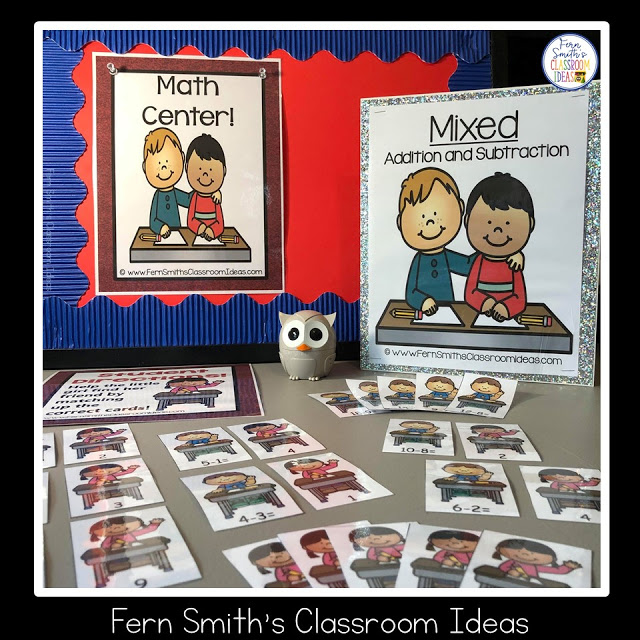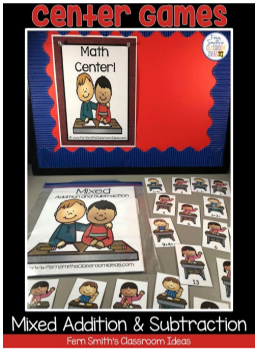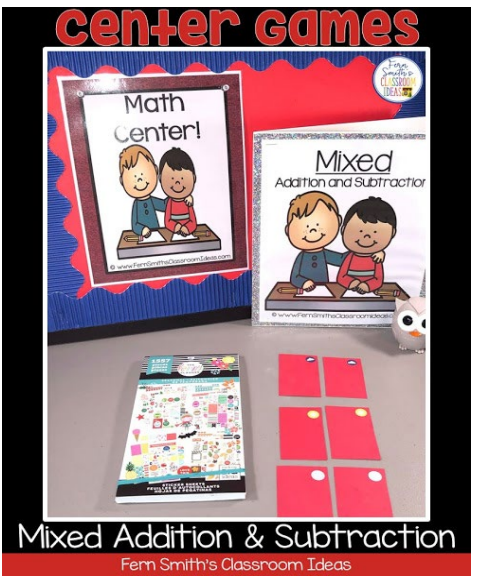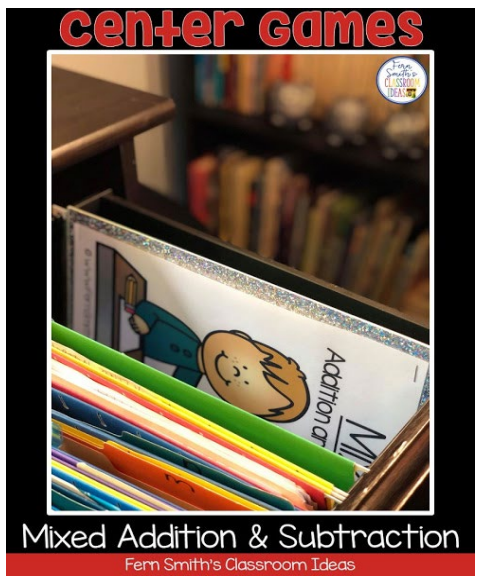Download This Back to School Mixed Addition and Subtraction Center Games Freebie Resource For Your Class Today!
Looking to add some excitement to your center time? This Back to School Mixed Addition and Subtraction Center Games Freebie Resource has highly engaging center games for Mixed Addition and Subtraction, that are quick and easy to prep and can be used for a variety of games, concentration, match game, go fish, rummy, scoot, read the room, self checking, even perfect for assessments.

Once your students play with this deck, many of my other Quick and Easy to Prep centers can be used for different skills and seasons. Your center time will run smoothly and with very little prep from you! Download this FREE Back to School Mixed Addition and Subtraction Center Games Today!
More Back to School Fun For Your Classroom
Time to the Hour and Half Hour Clip Cards September Bundle
Using Guided Reading for a Classroom Culture of Respect - Following Directions
Back to School Color By Number Four Pack Bundle
***Terrific Teacher Feedback!***
- Mach 1 Learning (TpT Seller) said, "My 5th graders are Big Buddies to the Kinder and 1st grade teachers. Once a week we will spend 30 minutes working on a skill. This has been a great resource for me to model to my 5th graders so they would be able to work with their Little Buddy. They have to practice with each other and show mastery of a skill before I let them visit. This has been a sneaky way for me to teach math review to my 5th graders! :) I found the remote learning had massive gaps in their knowledge. Thanks for providing this tool for me to help my students grow."
- Stephanie Wasto said, "My students have enjoyed the math games. The games are very age appropriate and the students needed little to no instruction to get them started. I have used this activity as a Math Center."

These centers are quick and easy to prepare, and they can be used for a variety of games... concentration, match game, go fish, scoot, read the room, they can be made to be self checking, and even perfect for assessments. Once your students play with this deck, many of my other Quick and Easy to Prep centers can be used for different skills and seasons. Your center time will run smoothly and with very little prep from you!
This Quick and Easy to Prep Mixed Addition Center Game example is perfect for your student led math center. Add some math manipulatives of your choice based on your students’ needs. I love the plastic bear counters and have even used them as high up as 3rd grade. Third grades are still only 8 and 9-year-old children and it adds a little fun to your math center.
Research shows that teachers must spend too much classroom time SHOWING and TEACHING their students how to play different center games.
Changing up different styles of center games each week leads to two different outcomes.
1. The students learn how to play a new game, but they don't play it enough to learn and review the SKILL that was the original intent of the game. Remember the first time you played Clue or Monopoly? You spent A LOT of time learning the GAME, the RULES, but not the problem solving that goes with winning those game. After 3 or 4 times playing the game, you LEARNED how to focus on the problem solving, the WINNING of the game, since you finally know the routine and the rules. The same negative outcome happens with changing the type of center each week for our students.
2. It takes so much time to teach new games each week that teachers interviewed stated that they simply did not have time. So those teachers tend not to do math stations, math centers. In the long run, their students lose the life skills that come from games. Cooperation, good sportsmanship, strategic planning, problem solving, independence, critical thinking skills, etc. AND teachers miss out on having quality small group time with their students.

This Quick and Easy to Prep Mixed Addition and Subtraction Center Game is Perfect for a Review for Back to School. Perfect for a Make It Take It Activity for Meet the Parents, Open House, Math Night, etc.
I've created most of my center games to be easy to print, cut, laminate {if desired} and store in their classroom. Pieces are easy to cut, either square shaped, or rectangular, perfect for a paper slicer!
Different Ways to Use My Center Games In Your Classroom
Keep one page as a game board, do not cut out the individual playing cards. Then, cut out the matching cards. It doesn't matter if you cut out the problems and keep the answers as the game board, like the picture shows, or cut out the answers and keep the problems as the game board. Your students will get practice either way. If printing is no problem, you can create two different centers, one with the problem page as the game board and another one with the answer page as the game board.
Another way to play is to cut out all the cards, answers and problems and mix them all together.

This picture shows one way to differentiate this game. It only has the subtraction problems and answers at the center.

This picture has just the addition problems and answers for a different skill review. If a little background noise doesn't bother, I use to teach my students how to use a timer at the beginning of the year. The owl in this picture is a timer, if center time is 10 minutes in your class, teach them to set it for 9 minutes. When the timer rings, they will know to clean up because they will be rotating in a minute. If you have 15 minutes for small group, teach them to set it for 14 minutes. They love using a timer, it makes them feel grown up! :)

This picture shows that if space is at a premium in your classroom, and you don't have set center areas, storing the center in a folder lets the students take it back to their seat, under their seat on the floor, or a quiet corner in the room and have a "CENTER" all ready to use. This becomes even lower prep for you once you teach them where to get the center and the expectations when using that center. As you know, two pocket folders are dirt cheap during the back to school sales. I know I have been on teams at different schools where we NEVER used the pocket folders that the school supply list at Wal*Mart had listed for our grade level. This way, using them for centers makes me feel a little better about the money the parents spent on them. Also, in the past, I have asked parents for these folders when the stores had them marked down to ten and five cents.

This picture shows another way that I really liked, and one that worked well with my third graders. Keep everything in a gallon Ziploc baggie. The older students can handle the zipper at the top and you will end up with fewer missing pieces. Once, when I had a very small classroom, center time and silent reading time was the only time they were allowed UNDER their desks, we called it our forts to make that time special. Ziploc baggies work well for students that need to pick up the center game and move it to their desk to work on that skill. When using a gallon Ziploc, I put the cover in so that it was showing on one side, and then the directions showing on the other side. I taught the students that they did not have to pull out those two pages. This works well if laminating is costly and not easily available at your school. Those two pages will keep well in the Ziploc baggie.

Another Way to Play
To play a very basic center game, when you prep your card deck, use different color Sharpie Markers to make matching symbols on the back of matching cards. Then the student turns all the cards face up / problem and answer side up and lays them out on the floor or table. They work the math, mentally, or with a white board, and then flip the two pairs over to see a matching symbol on the back to know it is the correct pair.
For remediation of your low babies, you can do like my photo example and just do three or four pairs of problems at your small group time. This will allow them fewer answers to select from and be more successful in reviewing their facts.

Another Fun Idea
This is just like the above directions, but when you prep your card deck, use cute little stickers to make matching pictures on the back of matching cards. I know when I buy stickers for my planners, I always have a lot of those little-bitty stickers left over after I use the big, fun ones! Those stickers are perfect for this.

Another Fun Idea
I know I said that two pocket folders are inexpensive, but I wanted to share this folder I found, it's front cover is all glittery and it was worth the little extra expense for a little sparker at my center! I also created some math center cards with red card stock so that the students in my small group remediation group felt like it was a different {a new} center just for them with fewer cards. Just one more little tip, but the possibilities are endless!

Another Fun Idea
I like to store my center games in a filing cabinet, both the folder option and the baggie option fit nicely into your files. I have spent most of my career in primary education, which is usually seasonal, so I keep all my files by month, August at the front and working my way back to June! I hope some of these suggestions help you with your small group time by having some engaging games for your other students at centers.

MATH CENTER SNAP!
THE OBJECT OF THE GAME
The goal is to win all or most of the cards.
DEAL
Deal five cards face down, one at a time, to each player. Each player puts their cards in a pile, face down in front of them.
HOW TO PLAY
The youngest student gets to go first. They turn over the top card of the pile and put it face up starting a pile of cards next to the extra face down card pile. The next player to the left does the same and so on around the table, clockwise.
When someone turns up a card that matches a card already face up, the first person to notice the two matched cards calls out “Snap!” and wins the cards. This player displays the two matching cards in front of them. During the game, if a player runs out of cards in their face-down pile, they pick up five new cards from the extra card pile, or less than five if the pile is running low. The winner has the most pairs of cards at the end of center time.

MATH CENTER CONCENTRATION!
THE OBJECT OF THE GAME
The goal is to win all or most of the cards. This is an excellent ONE PLAYER game.
DEAL
To play Match Game or Concentration, the student turns all the cards over face down / problem and answer side down and lays them out on the floor or table.
HOW TO PLAY
This works well with colored card stock so they can not see thru the cards. My picture was just regular copy paper for a photo example and you can peek and see the answers. ;) During the game, the student keeps all matching pairs and the object is to collect the most pairs by the end of center time. This can also be an excellent two or three player game by taking turns.
MATH CENTER GO FISH!
THE OBJECT OF THE GAME
The goal is to win all or most of the cards.
DEAL
Deal five cards face down, one at a time, to each player. Each player puts their cards in their hand so they can read them.
HOW TO PLAY
The youngest student gets to go first. They ask another student, "do you have 12-8= 4?" They may ask this question if they have the answer card or the problem card. Teach this at the beginning of the year, so they mentally work the math out and SPECIFICALLY gain practice with the math.... ultimately the objective of all your math center games. The other student will give them the card or if they do not have that card, "Go Fish" and the asking student will pull a card for the extra card pile. If they get their exact match, they may go again, from their friend or the extra pile. If not, it is the next student's turn. The winner has the most pairs of cards at the end of center time.

To recap, this math resource includes:
A center coverA math center sign
Four pages of playing cards
Student directions
NEW FREE BONUS FILE - A 12 page letter from me!
A Twelve Page Letter From Me! This letter includes many ways to use Center Games, Task Cards, and Color By Number in your classroom! These 12 pages are a free bonus for my WONDERFUL teacher followers! Thank you for all you do!
SEAT WORK DOESN'T HAVE TO BE BORING! :)
Common Core Standards
CCSS.MATH.CONTENT.K.OA.A.2
Solve addition and subtraction word problems, and add and subtract within 10, e.g., by using objects or drawings to represent the problem.
CCSS.MATH.CONTENT.K.OA.A.5
Fluently add and subtract within 5.
CCSS.MATH.CONTENT.1.OA.C.5
Relate counting to addition and subtraction (e.g., by counting on 2 to add 2).
CCSS.MATH.CONTENT.2.OA.B.2
Fluently add and subtract within 20 using mental strategies. By end of Grade 2, know from memory all sums of two one-digit numbers.


